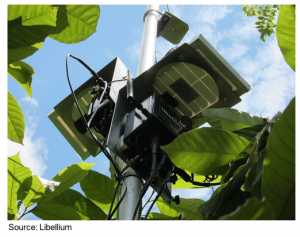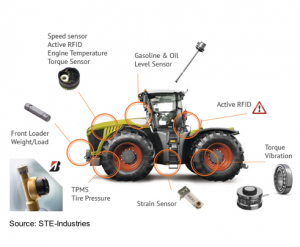 Agriculture – Historically, the way irrigation systems are deployed on farms, the all areas of a field will be irrigated equally regardless of how much water is actually needed. With a smart IoT irrigation system using soil moisture sensors and feedback control systems, water can be distributed according to what is actually needed. Smart irrigation is also integrated with weather prediction data for more complete optimization. Other IoT services can include geo-location based soil sampling and drone based thermal or spectroscopic imaging that can tie back to applications that optimize fertilizer plans, seed distribution and crop protection plans. In-ground sensors can also detect the concentration of ions in soil liquids which correlate to the nutrients levels in different areas of the field. Smart systems to enable so called “precision farming” to improve operational efficiency in fertalizing, planting, and harvesting.
Agriculture – Historically, the way irrigation systems are deployed on farms, the all areas of a field will be irrigated equally regardless of how much water is actually needed. With a smart IoT irrigation system using soil moisture sensors and feedback control systems, water can be distributed according to what is actually needed. Smart irrigation is also integrated with weather prediction data for more complete optimization. Other IoT services can include geo-location based soil sampling and drone based thermal or spectroscopic imaging that can tie back to applications that optimize fertilizer plans, seed distribution and crop protection plans. In-ground sensors can also detect the concentration of ions in soil liquids which correlate to the nutrients levels in different areas of the field. Smart systems to enable so called “precision farming” to improve operational efficiency in fertalizing, planting, and harvesting.
 Smart farming vehicles are instrumented via GPS to allow them to be operated with autopilot and smart tools can be controlled to operate based on data from sensors and analytics to optimize field coverage and to control seed, fertilizer and pest control distribution rates according to a field optimization and yield plan. With the integration of data on the conditions of nutrients in the soil, moisture conditions, weather patterns, geo-location information and crop history information all tied into the operations of irrigation, planting, harvesting and heavy equipment operation and maintenance, IoT stands to have a huge benefit for agriculture. The economic drivers here will be seen in yields, labor savings, and operational costs.
Smart farming vehicles are instrumented via GPS to allow them to be operated with autopilot and smart tools can be controlled to operate based on data from sensors and analytics to optimize field coverage and to control seed, fertilizer and pest control distribution rates according to a field optimization and yield plan. With the integration of data on the conditions of nutrients in the soil, moisture conditions, weather patterns, geo-location information and crop history information all tied into the operations of irrigation, planting, harvesting and heavy equipment operation and maintenance, IoT stands to have a huge benefit for agriculture. The economic drivers here will be seen in yields, labor savings, and operational costs.
